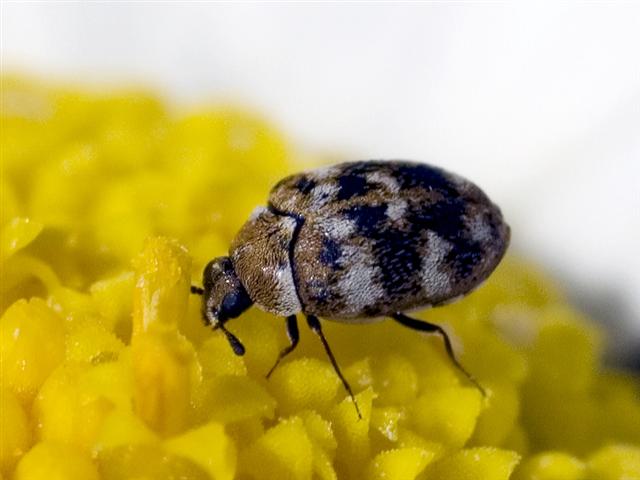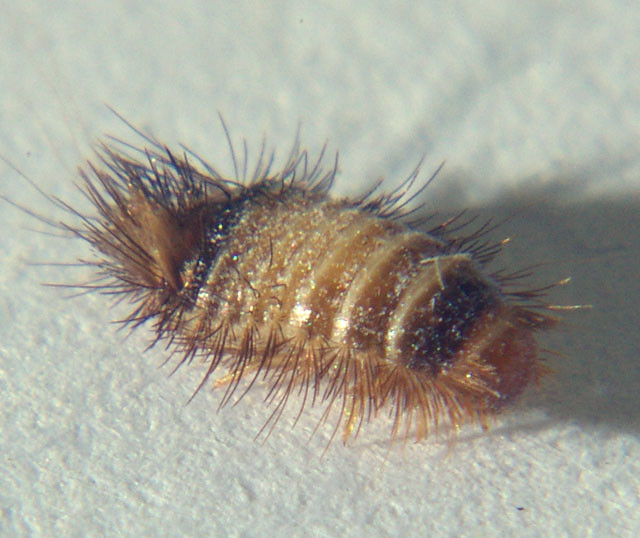
We’ve all been through nightmares imagining cockroaches, rats, and mice invading our house, but some pests are too tiny for us to spot, and that’s why they can be more damaging. What might appear to be a small black dot on your white sheets or clothing blanket can be the first indication of carpet beetles. These pests aren’t dangerous to humans but destroy anything that resembles nature, like fibres, clothes, furniture, wool, and most things around your living room. To make matters worse, they have wings which makes them agile and equally difficult to get rid of.
What Are Carpet Beetles?
Carpet beetles have been around Canada for a long time and have different names, including varied carpet beetle and furniture beetles. They are domestic pests that feed on fabric, dead insects, and even accumulated pet hair. Notorious for damaging furnishings, they are often confused with clothes moths, but carpet beetles and clothes moths tend to have different behaviours. Adult carpet beetles feed on pollen and outdoor plants, but their larvae’s diet includes fabric. They can easily enter your house through any cracks and openings or through birds and even pets.
Identifying Carpet Beetles
Finding out what carpet beetles look like won’t be easy. You might need to grab a magnifying glass because of how small they are, but this will remove any doubts about other non-harming natural bugs.
Adult Carpet Beetles Identification
Colour: Adult carpet beetles have a range of colours, from orange, brown, and yellow to black. You would commonly find them in darker colours.
Size: Their lengths are really small. They can be anywhere between 1/16” to ⅛ inch long
Shape: Oval-shaped with tiny antennae and 6 legs
Adult carpet beetles aren’t the biggest problem, varied carpet beetle larvae are the real culprit and the worry for most people. These larvae feed on fabric found anywhere, and most places where they go unchecked are the attic and the closet. Has an old carpet rolled in the closet? This might be a good call to check for these larvae.

Carpet Beetle Larvae Identification
Colour: The larvae can have brown or darker colours with striped marks
Size: Carpet beetle larvae can have a length between 5/32” to 7/32”
Description: They have hair all over their bodies
Shape: They are long and tubular shaped upon close inspection

Carpet Beetle Behaviour
Carpet beetles feed on fibre proteins or more commonly known as keratin. That’s the same thing found in hair. Black carpet beetle larvae will eat anything that resembles fibres. While eating these larvae tend to move and can leave holes in different places, they also shed skin and leave behind their remains. Female carpet beetles can lay as many as 100 eggs, and they commonly do this around signs of organic materials like ducts and closet space.
Within weeks, the carpet beetle eggs hatch and turn into hairy, elongated larvae that immediately turn to dark places, where they can feed undisturbed. Their life cycle untill the larvae stage is short, but they can live for months before turning into adult beetles. Once they develop wings, they can easily reach other places, like air vents, attics, and chimneys. Here, they can feed on dead insects and dry lint hair collected over time.
Signs of Carpet Beetle Infestation
Finding these tiny pests will be challenging, but if you know where to look, you can assess just how bad the infestation is.
- Check for holes in clothes. Carpet beetle larvae feed randomly and move on the surface, which makes many holes in a single piece of clothing
- Observe for similar marks on furniture
- As the larvae feed, they shed their skin many times. Finding this striped shell can be a major sign of infestation
- Check the underside and corners of the rugs. This is the most common place for these beetles.
Spotting these signs isn’t easy. Preventive measures are better than looking for these signs of carpet beetle infestation in the first place.
Controlling Carpet Beetle Infestation
If you see any of these signs, there’s a good chance they have already spread to other areas. As a homeowner, there are some things you can do that can stop their spread and stop them from multiplying.
Carpet beetles feed on plant material and can easily come inside if you have a garden. Sanitizing and cleaning your house regularly can stop most bugs from spreading and infesting. One of the most effective ways of preventing carpet beetles is to check storage and closets every once in a while. This can lead to finding an infestation early, which may not require pest control. If you suspect these pests inside your laundry, old clothes, woollen furnishings, or any other material, dry cleaning is the only solution to get rid of carpet beetles. Carpet beetles can contaminate food sources, and one of the ways they make it to your kitchen, and upholstered furniture is through ducts and by simply flying around. Have your air vents and ducts cleaned for accumulated lint, hair, and dust.
Most Effective Carpet Beetle Infestation Solution
Carpet beetle infestations are a difficult problem for homeowners. They damage property, contaminate food and can cause allergic reactions. On top of all that, they can easily spread to your car and office. The best way to get rid of carpet beetles is to have professionals assess the spread of the contamination and offer a one-time effective solution. This is better than using controlling measures for weeks without guaranteeing results. If you own a valuable taxidermy collection, you should immediately contact pest control and have them handle the infestation, minimizing damage.
Action Pest offers all types of bug and pest control services in Canada. We are committed to solving infestation problems and are at the service 24/7. Infestations spread quickly, so it’s recommended to reach us on the first signs you spot.







